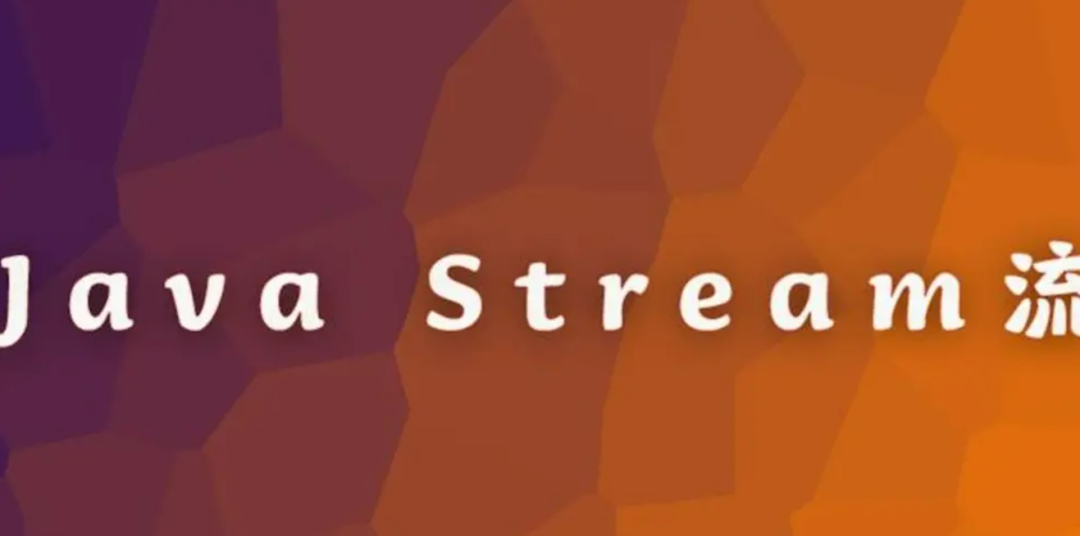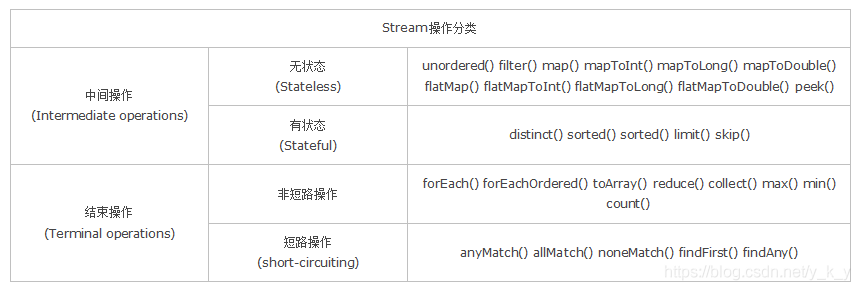玩转Java8 Stream,代码效率飞升
点击上方“码农突围”,马上关注 这里是码农充电第一站,回复“666”,获取一份专属大礼包 真爱,请设置“星标”或点个“在看”

文章来源:http://b.nxw.so/1rlrOw
概述
分类
具体用法
概述
Stream 是 Java8 中处理集合的关键抽象概念,它可以指定你希望对集合进行的操作,可以执行非常复杂的查找、过滤和映射数据等操作。
使用 Stream API 对集合数据进行操作,就类似于使用 SQL 执行的数据库查询。也可以使用 Stream API 来并行执行操作。
简而言之,Stream API 提供了一种高效且易于使用的处理数据的方式。
特点如下:
不是数据结构,不会保存数据。
不会修改原来的数据源,它会将操作后的数据保存到另外一个对象中。(保留意见:毕竟 peek 方法可以修改流中元素)
惰性求值,流在中间处理过程中,只是对操作进行了记录,并不会立即执行,需要等到执行终止操作的时候才会进行实际的计算。
分类

如上图:
无状态:指元素的处理不受之前元素的影响
有状态:指该操作只有拿到所有元素之后才能继续下去
非短路操作:指必须处理所有元素才能得到最终结果
短路操作:指遇到某些符合条件的元素就可以得到最终结果,如 A || B,只要 A 为 true,则无需判断 B 的结果
具体用法
| 流的常用创建方法
使用 Collection 下的 stream() 和 parallelStream() 方法:
List<String> list = new ArrayList<>();
Stream<String> stream = list.stream(); //获取一个顺序流
Stream<String> parallelStream = list.parallelStream(); //获取一个并行流
使用 Arrays 中的 stream() 方法,将数组转成流:
Integer[] nums = new Integer[10];
Stream<Integer> stream = Arrays.stream(nums);
使用Stream中的静态方法:of()、iterate()、generate()
Stream<Integer> stream = Stream.of(1,2,3,4,5,6);
Stream<Integer> stream2 = Stream.iterate(0, (x) -> x + 2).limit(6);
stream2.forEach(System.out::println); // 0 2 4 6 8 10
Stream<Double> stream3 = Stream.generate(Math::random).limit(2);
stream3.forEach(System.out::println);
使用 BufferedReader.lines() 方法,将每行内容转成流:
BufferedReader reader = new BufferedReader(new FileReader("F:\\test_stream.txt"));
Stream<String> lineStream = reader.lines();
lineStream.forEach(System.out::println);
使用 Pattern.splitAsStream() 方法,将字符串分隔成流:
Pattern pattern = Pattern.compile(",");
Stream<String> stringStream = pattern.splitAsStream("a,b,c,d");
stringStream.forEach(System.out::println);
| 流的中间操作
筛选与切片:
filter:过滤流中的某些元素
limit(n):获取 n 个元素
skip(n):跳过 n 元素,配合 limit(n) 可实现分页
distinct:通过流中元素的 hashCode() 和 equals() 去除重复元素
Stream<Integer> stream = Stream.of(6, 4, 6, 7, 3, 9, 8, 10, 12, 14, 14);
Stream<Integer> newStream = stream.filter(s -> s > 5) //6 6 7 9 8 10 12 14 14
.distinct() //6 7 9 8 10 12 14
.skip(2) //9 8 10 12 14
.limit(2); //9 8
newStream.forEach(System.out::println);
映射:
map:接收一个函数作为参数,该函数会被应用到每个元素上,并将其映射成一个新的元素。
flatMap:接收一个函数作为参数,将流中的每个值都换成另一个流,然后把所有流连接成一个流。
List<String> list = Arrays.asList("a,b,c", "1,2,3");
//将每个元素转成一个新的且不带逗号的元素
Stream<String> s1 = list.stream().map(s -> s.replaceAll(",", ""));
s1.forEach(System.out::println); // abc 123
Stream<String> s3 = list.stream().flatMap(s -> {
//将每个元素转换成一个stream
String[] split = s.split(",");
Stream<String> s2 = Arrays.stream(split);
return s2;
});
s3.forEach(System.out::println); // a b c 1 2 3
排序:
sorted():自然排序,流中元素需实现 Comparable 接口
sorted(Comparator com):定制排序,自定义 Comparator 排序器
List<String> list = Arrays.asList("aa", "ff", "dd");
//String 类自身已实现Compareable接口
list.stream().sorted().forEach(System.out::println);// aa dd ff
Student s1 = new Student("aa", 10);
Student s2 = new Student("bb", 20);
Student s3 = new Student("aa", 30);
Student s4 = new Student("dd", 40);
List<Student> studentList = Arrays.asList(s1, s2, s3, s4);
//自定义排序:先按姓名升序,姓名相同则按年龄升序
studentList.stream().sorted(
(o1, o2) -> {
if (o1.getName().equals(o2.getName())) {
return o1.getAge() - o2.getAge();
} else {
return o1.getName().compareTo(o2.getName());
}
}
).forEach(System.out::println);
消费:
peek:如同于 map,能得到流中的每一个元素。但 map 接收的是一个 Function 表达式,有返回值;而 peek 接收的是 Consumer 表达式,没有返回值。
Student s1 = new Student("aa", 10);
Student s2 = new Student("bb", 20);
List<Student> studentList = Arrays.asList(s1, s2);
studentList.stream()
.peek(o -> o.setAge(100))
.forEach(System.out::println);
//结果:
Student{name='aa', age=100}
Student{name='bb', age=100}
| 流的终止操作
匹配、聚合操作:
allMatch:接收一个 Predicate 函数,当流中每个元素都符合该断言时才返回 true,否则返回 false
noneMatch:接收一个 Predicate 函数,当流中每个元素都不符合该断言时才返回 true,否则返回 false
anyMatch:接收一个 Predicate 函数,只要流中有一个元素满足该断言则返回 true,否则返回 false
findFirst:返回流中第一个元素
findAny:返回流中的任意元素
count:返回流中元素的总个数
max:返回流中元素最大值
min:返回流中元素最小值
List<Integer> list = Arrays.asList(1, 2, 3, 4, 5);
boolean allMatch = list.stream().allMatch(e -> e > 10); //false
boolean noneMatch = list.stream().noneMatch(e -> e > 10); //true
boolean anyMatch = list.stream().anyMatch(e -> e > 4); //true
Integer findFirst = list.stream().findFirst().get(); //1
Integer findAny = list.stream().findAny().get(); //1
long count = list.stream().count(); //5
Integer max = list.stream().max(Integer::compareTo).get(); //5
Integer min = list.stream().min(Integer::compareTo).get(); //1
规约操作:
①Optional<T> reduce(BinaryOperator<T> accumulator):第一次执行时,accumulator 函数的第一个参数为流中的第一个元素,第二个参数为流中元素的第二个元素。
第二次执行时,第一个参数为第一次函数执行的结果,第二个参数为流中的第三个元素;依次类推。
②T reduce(T identity, BinaryOperator<T> accumulator):流程跟上面一样,只是第一次执行时,accumulator 函数的第一个参数为 identity,而第二个参数为流中的第一个元素。
③<U> U reduce(U identity,BiFunction<U, ? super T, U> accumulator,BinaryOperator<U> combiner):在串行流(stream)中,该方法跟第二个方法一样,即第三个参数 combiner 不会起作用。
在并行流(parallelStream)中,我们知道流被 fork join 出多个线程进行执行,此时每个线程的执行流程就跟第二个方法 reduce(identity,accumulator)一样。
而第三个参数 combiner 函数,则是将每个线程的执行结果当成一个新的流,然后使用第一个方法 reduce(accumulator)流程进行规约。
//经过测试,当元素个数小于24时,并行时线程数等于元素个数,当大于等于24时,并行时线程数为16
List<Integer> list = Arrays.asList(1, 2, 3, 4, 5, 6, 7, 8, 9, 10, 11, 12, 13, 14, 15, 16, 17, 18, 19, 20, 21, 22, 23, 24);
Integer v = list.stream().reduce((x1, x2) -> x1 + x2).get();
System.out.println(v); // 300
Integer v1 = list.stream().reduce(10, (x1, x2) -> x1 + x2);
System.out.println(v1); //310
Integer v2 = list.stream().reduce(0,
(x1, x2) -> {
System.out.println("stream accumulator: x1:" + x1 + " x2:" + x2);
return x1 - x2;
},
(x1, x2) -> {
System.out.println("stream combiner: x1:" + x1 + " x2:" + x2);
return x1 * x2;
});
System.out.println(v2); // -300
Integer v3 = list.parallelStream().reduce(0,
(x1, x2) -> {
System.out.println("parallelStream accumulator: x1:" + x1 + " x2:" + x2);
return x1 - x2;
},
(x1, x2) -> {
System.out.println("parallelStream combiner: x1:" + x1 + " x2:" + x2);
return x1 * x2;
});
System.out.println(v3); //197474048
收集操作:
collect:接收一个 Collector 实例,将流中元素收集成另外一个数据结构。
Collector<T, A, R> 是一个接口,有以下 5 个抽象方法:
Supplier<A> supplier():创建一个结果容器 A
BiConsumer<A, T> accumulator():消费型接口,第一个参数为容器 A,第二个参数为流中元素 T。
BinaryOperator<A> combiner():函数接口,该参数的作用跟上一个方法(reduce)中的 combiner 参数一样,将并行流中各个子进程的运行结果(accumulator 函数操作后的容器 A)进行合并。
Function<A, R> finisher():函数式接口,参数为:容器 A,返回类型为:collect 方法最终想要的结果 R。
Set<Characteristics> characteristics():返回一个不可变的 Set 集合,用来表明该 Collector 的特征。
CONCURRENT:表示此收集器支持并发。(官方文档还有其他描述,暂时没去探索,故不作过多翻译)
UNORDERED:表示该收集操作不会保留流中元素原有的顺序。
IDENTITY_FINISH:表示 finisher 参数只是标识而已,可忽略。
Collector 工具库:Collectors
Student s1 = new Student("aa", 10,1);
Student s2 = new Student("bb", 20,2);
Student s3 = new Student("cc", 10,3);
List<Student> list = Arrays.asList(s1, s2, s3);
//装成list
List<Integer> ageList = list.stream().map(Student::getAge).collect(Collectors.toList()); // [10, 20, 10]
//转成set
Set<Integer> ageSet = list.stream().map(Student::getAge).collect(Collectors.toSet()); // [20, 10]
//转成map,注:key不能相同,否则报错
Map<String, Integer> studentMap = list.stream().collect(Collectors.toMap(Student::getName, Student::getAge)); // {cc=10, bb=20, aa=10}
//字符串分隔符连接
String joinName = list.stream().map(Student::getName).collect(Collectors.joining(",", "(", ")")); // (aa,bb,cc)
//聚合操作
//1.学生总数
Long count = list.stream().collect(Collectors.counting()); // 3
//2.最大年龄 (最小的minBy同理)
Integer maxAge = list.stream().map(Student::getAge).collect(Collectors.maxBy(Integer::compare)).get(); // 20
//3.所有人的年龄
Integer sumAge = list.stream().collect(Collectors.summingInt(Student::getAge)); // 40
//4.平均年龄
Double averageAge = list.stream().collect(Collectors.averagingDouble(Student::getAge)); // 13.333333333333334
// 带上以上所有方法
DoubleSummaryStatistics statistics = list.stream().collect(Collectors.summarizingDouble(Student::getAge));
System.out.println("count:" + statistics.getCount() + ",max:" + statistics.getMax() + ",sum:" + statistics.getSum() + ",average:" + statistics.getAverage());
//分组
Map<Integer, List<Student>> ageMap = list.stream().collect(Collectors.groupingBy(Student::getAge));
//多重分组,先根据类型分再根据年龄分
Map<Integer, Map<Integer, List<Student>>> typeAgeMap = list.stream().collect(Collectors.groupingBy(Student::getType, Collectors.groupingBy(Student::getAge)));
//分区
//分成两部分,一部分大于10岁,一部分小于等于10岁
Map<Boolean, List<Student>> partMap = list.stream().collect(Collectors.partitioningBy(v -> v.getAge() > 10));
//规约
Integer allAge = list.stream().map(Student::getAge).collect(Collectors.reducing(Integer::sum)).get(); //40
Collectors.toList() 解析:
//toList 源码
public static <T> Collector<T, ?, List<T>> toList() {
return new CollectorImpl<>((Supplier<List<T>>) ArrayList::new, List::add,
(left, right) -> {
left.addAll(right);
return left;
}, CH_ID);
}
//为了更好地理解,我们转化一下源码中的lambda表达式
public <T> Collector<T, ?, List<T>> toList() {
Supplier<List<T>> supplier = () -> new ArrayList();
BiConsumer<List<T>, T> accumulator = (list, t) -> list.add(t);
BinaryOperator<List<T>> combiner = (list1, list2) -> {
list1.addAll(list2);
return list1;
};
Function<List<T>, List<T>> finisher = (list) -> list;
Set<Collector.Characteristics> characteristics = Collections.unmodifiableSet(EnumSet.of(Collector.Characteristics.IDENTITY_FINISH));
return new Collector<T, List<T>, List<T>>() {
@Override
public Supplier supplier() {
return supplier;
}
@Override
public BiConsumer accumulator() {
return accumulator;
}
@Override
public BinaryOperator combiner() {
return combiner;
}
@Override
public Function finisher() {
return finisher;
}
@Override
public Set<Characteristics> characteristics() {
return characteristics;
}
};
}
(完)
码农突围资料链接
1、卧槽!字节跳动《算法中文手册》火了,完整版 PDF 开放下载!
2、计算机基础知识总结与操作系统 PDF 下载
3、艾玛,终于来了!《LeetCode Java版题解》.PDF
4、Github 10K+,《LeetCode刷题C/C++版答案》出炉.PDF欢迎添加鱼哥个人微信:smartfish2020,进粉丝群或围观朋友圈
